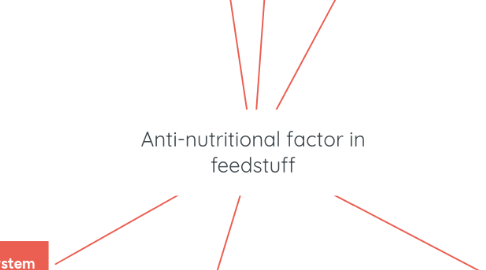
1. Sources
1.1. Alkaloids
1.1.1. Tobacco, green potatoes, tomatoes, nightshade false Hellebore
1.2. Glycoside
1.2.1. Sorghums, Jhonson Grass, cabbage, Kale, Rapeseed, Clover Hay, Foxgloves, milk weed, alfafa, soyabean, chick pea
1.3. Protein
1.3.1. Soyabean, rye, alfafa, bracken fern
1.4. Metal-binding substances
1.4.1. Paddy straw, anjan grass, cereal grains, soya bean meal,
2. Defined as substance that impair some aspects of animal metabolism and produce adverse biological/economic effects in animal production, under practical circumstances.
3. Effect on Biological System
3.1. Alkaloid
3.1.1. Pyrrolizidine
3.1.1.1. liver cirrhosis
3.1.2. Piperidine
3.1.2.1. affect central nervous system; teratogenic
3.1.3. Indole
3.1.3.1. Bovine Pulmonary Emphysema
3.1.4. Quinolizidine
3.1.4.1. acute poisoning in sheep
3.1.5. Steriod
3.1.5.1. poisons and cholinesterase inhibitors
3.1.5.2. teratogenic effects in lambs; prolonged gestation in ewesbitiors
3.1.6. Indolizine
3.1.6.1. inhibitors of alpha-mannosidase, resulting in accumulation of mannose deposits in lysosomes of nerve cells
3.1.7. Tryptamine
3.1.7.1. phalaris poisoning results in acute neurological signs and chronic muscular incordination
3.2. Glycosides
3.2.1. Cyanogenic
3.2.1.1. potent inhibitor of cytochrome oxidase, a respiratory enzyme
3.2.2. Goitoregenic (glucosinolates)
3.2.2.1. Decrease production of thyroid hormones, goitre
3.2.3. Coumarin
3.2.3.1. Vit-K deficiency
3.2.4. Steroid and triterpenoid
3.2.4.1. Cardiac glycosides
3.2.4.1.1. Potent stimulator of heart rate
3.2.4.2. Saponins
3.2.4.2.1. Bitter taste and affect palatability and cause bloat in ruminants; growth depression in poultry and swine
3.3. Proteins
3.3.1. Protease and amylase inhibitors
3.3.1.1. they bind and inactive the digestive enzyme trypsin in small intestine, cause reduced growth and pancreatic hypertrophy
3.3.2. Lectins (hemagglutinins)
3.3.2.1. Agglutination (clumping) of red cells, reduced growth, diarrhoea and interfere with nutrient absorption
3.3.3. Enzymes (Thiaminase and Lipoxidase)
3.3.3.1. cleaves B vitamin thiamine, inactivate it and cause thiamine deficiency; Chastek's paralysis in minks; degrade fat souble
3.3.4. Amino Acids and amino acids derivatives
3.3.4.1. Mimosine
3.3.4.1.1. Cause reduced growth rate and alopesia non ruminants and goitre in ruminants
3.3.4.2. Trytophan
3.3.4.2.1. Under certain conditions it is metabolised to 3-methylindole and cause acute bovine pulmonary emphysema
3.4. Metal-binding substances
3.4.1. Oxalates
3.4.1.1. They chelate calcium and produce hypocalcemia
3.4.2. Phytates
3.4.2.1. reduce mineral availability, particularly zinc through formation of insoluble phytates in addition to low phosphorus availability in non-ruminants
3.4.3. Mimosine
3.4.3.1. Binds copper and zinc ions more strongly than most amino acids
4. Classification of Anti Nutritional Factor
4.1. Chemical Structure
4.2. Occurence in feed
4.3. Site of action
4.4. Metabolic effect
5. Chemical Nature
5.1. Alkaloid
5.1.1. Pyrrolizidine
5.1.1.1. nucleus consist of two five five membered ring
5.1.2. Indole
5.1.2.1. Derivatives of the amino acid trytophan
5.1.3. Quinolizidine
5.1.3.1. nucleus Lupines consists of two six membered rings
5.2. Glycosides
5.2.1. Cyanogenic
5.2.1.1. glycosides of sugar and a cyanide containing aglycone
5.2.2. Goiterogenic (glucosinolates)
5.2.2.1. thioethers containing organic aglycone
5.2.3. Coumarin
5.2.3.1. coumarin converted to dicoumarol my mould growth, an antagonist of Vit-K
5.2.4. Cardiac glycosides
5.2.4.1. contains a sterol group in their structure (digitonin; cardenolides)
5.2.5. Saponins
5.2.5.1. glycosides with foaming properties and forms stable foam
5.3. Proteins
5.3.1. Lectins (hemagglutinins)
5.3.1.1. glycoprotein of 60,000-100,000
5.3.2. mimosine
5.3.2.1. structure similar to tyrosine
5.4. Metal-binding substances
5.4.1. Oxalates
5.4.1.1. an organic dicarboxylic acid
5.4.2. Phytates
5.4.2.1. Salts of phytic acid
5.4.3. Mimosine
5.4.3.1. similar to tyrosine
6. Chemical Structure
6.1. Alkaloid
6.1.1. contain nitrogen, heterocyclic ring
6.1.2. bitter, more toxic
6.1.3. fruther classified on the basis of the chemical type of the nitrogen containing heterocyclic ring
6.2. Glycosides
6.2.1. ether containing carbohydrate moiety and a non-carbohydrate moiety (algycone) joined with an ether bond
6.3. Proteins
6.3.1. important inhibitors in plants
6.3.2. Protease: any enzyme that conducts proteolysis, that is, begins protein catabolism by hydrolysis of the peptide bonds that link amino acids together in the polypeptide chain. The function of peptidases is inhibited by protease inhibitor enzymes
6.4. Carbohydrates
6.4.1. Xylose, a hexose sugar causes reduced growth and eye cataract in pigs and poultry
6.4.2. non-starch polysaccharides (NSP) are not digested and they exerts certain harmful effects and reduce the availability of valuable nutrients in non-ruminants
6.5. Lipids
6.5.1. cyclopropenoid fatty acids, viz. sterculic and malvic acids in cotton seed, posses toxic properties and cause pink colourations in stored eggs
6.5.2. also cocarcinogens in increasing the carcinogenicity of aflatoxins
6.5.3. some fatty acids are toxic to the animals, including erucic acid in rapeseed, which causes myocardial infarction in rats
6.6. Metal-binding substances
6.6.1. some compounds have affinity to bind with some of the metals leading to mineral deficiencies in farm animals
6.7. Phenolic compounds
6.7.1. contain an aromatic ring (s) with one or more hydroxyl groups

